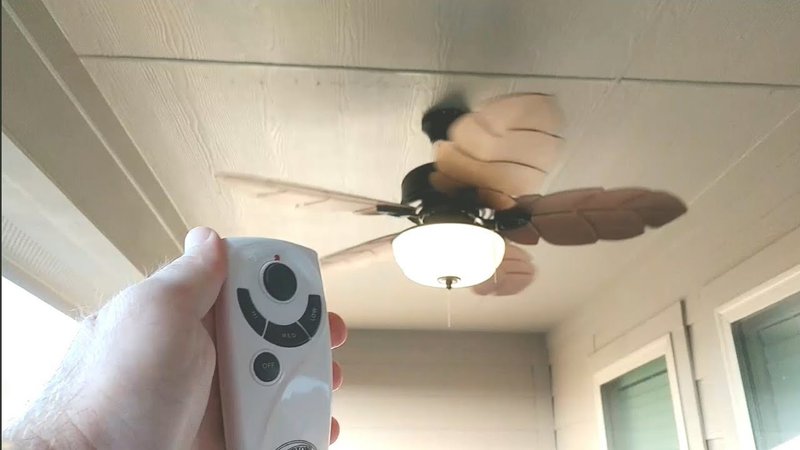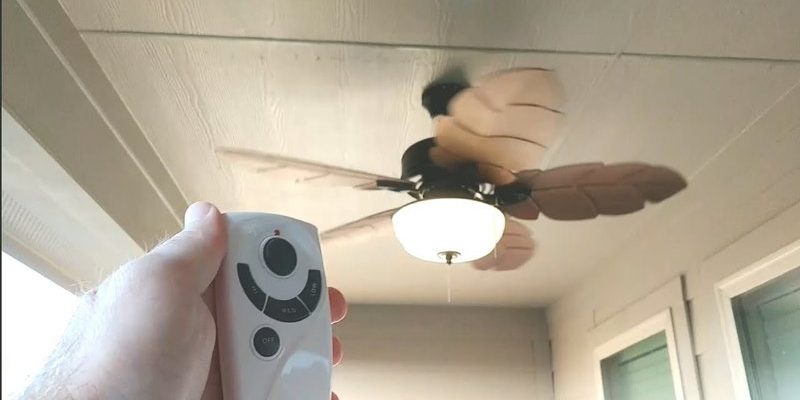
Here’s the thing: Hampton Bay ceiling fans are everywhere, especially in homes where comfort is king. Their remotes keep things easy—turning fans on, off, and changing speeds without leaving your chair. But remotes can be surprisingly good at disappearing when you need them most. The idea of using a smartphone instead isn’t just modern—it’s ridiculously practical. Let’s untangle how possible this is, what stands in the way, and whether there’s a magic fix (or at least a clever hack).
Understanding Hampton Bay Ceiling Fan Remotes
If you’ve ever held a Hampton Bay ceiling fan remote, it feels a bit retro—plastic buttons for speed, a light switch, maybe a reverse setting. The fan itself talks to the remote using *RF signals* (radio frequency) or, less often, *infrared* (like your old TV remote). Most Hampton Bay remotes rely on a simple code, usually set by little switches (called dip switches) inside the battery compartment. These codes make sure your neighbor’s remote doesn’t start spinning your fan at midnight.
Pairing the remote with your fan is usually straightforward. You match the code inside the remote to the one hidden in the fan receiver (up in the canopy, above the blades). After that, every button press “talks” directly to the fan, changing speed or toggling the light. Honestly, it’s old-school wireless—solid, but not smart.
But here’s something worth knowing: these remotes don’t use Wi-Fi or Bluetooth. That means your phone, out of the box, can’t “talk” to your fan in the same language. If you were hoping for a quick app download and instant control, I get it—but there’s a catch. Let me explain why these differences matter before we look at creative workarounds.
Why Your Smartphone Can’t Directly Replace a Hampton Bay Remote
You might be wondering, “My phone has Bluetooth, Wi-Fi, IR blaster—why can’t it just take over?” This comes down to the basic tech inside both devices. Hampton Bay’s standard remotes don’t use the same types of signals that your phone does. Most Androids and iPhones today can’t emit radio frequencies in the specific range needed, and infrared (if your fan even supports it) is pretty much extinct on new phones.
Remote apps in the Play Store or App Store usually work with TVs, air conditioners, or smart devices that use Wi-Fi or Bluetooth. A standard Hampton Bay ceiling fan remote speaks a language your phone doesn’t know by default. There’s no built-in support, no universal code database, and definitely no “sync” feature that lets the fan pair with your phone out of the box.
The other snag? Hampton Bay fans use simple, one-way communication: the remote just shouts commands, and the fan listens. There’s no “smart home” chip or Wi-Fi setup hiding in most models. That means traditional troubleshooting tips for smart bulbs or sockets—resetting, pairing, code scanning—won’t apply here.
Smartphone Control: When Is It Actually Possible?
Let’s not lose hope yet. While a standard Hampton Bay remote won’t work with your phone, there are situations where a smartphone can step in—if you’re willing to add a little tech magic. Here’s how it can actually work:
- Replace the receiver with a “smart” Wi-Fi or Bluetooth module: You can buy aftermarket receivers (like Bond Bridge, BroadLink, or certain Zigbee modules) that fit into your fan’s housing. These receivers get installed between your house wiring and the fan itself.
- Use a smart ceiling fan controller: These devices pair with your fan—sometimes they even come with their own remotes but, crucially, also offer app or voice control.
- Leverage a smart home hub: If you’re deep into Amazon Alexa, Google Home, or Apple HomeKit, you can sometimes integrate ceiling fan modules that let your phone (and even your voice) take over.
With these upgrades, your phone can actually *pair* with the new smart receiver, letting you control speed, turn on the light, or set timers—all from an app. This setup isn’t as quick as finding your old remote, but it’s way more flexible once you get it going. However, not every fan model will play nice, and you might need to do a bit of wiring or code syncing.
The Bond Bridge Example
Bond Bridge is a popular workaround—it “learns” your fan’s RF signal and lets your phone send replacements. Imagine it as a universal translator: you press buttons on your remote, the Bond “listens,” and then your phone speaks Bond’s language, which gets turned back into the signal your fan understands.
It’s not as cheap as a new remote, but if you want full phone control for multiple RF-controlled devices, it’s a clever solution.
Steps to Control Your Hampton Bay Fan With a Smartphone
If you’re set on retiring your physical remote, here’s a basic roadmap to follow. Take it slow, be safe (especially with wiring), and make sure you match the right products to your fan model.
- Identify your fan’s current receiver: Is it an internal RF module or old-school hardwired switches? Pop off the canopy and check.
- Shop for a compatible smart receiver: Look for units specifically made for ceiling fans, and double-check the wattage and compatibility. Some brands even list “Hampton Bay compatible.”
- Turn off the circuit breaker before installation: Don’t mess with wiring unless the power is completely off.
- Install the new receiver according to instructions: Usually, this involves replacing the old module, connecting to the “line” (power), “neutral,” and “load” (fan/light) wires. Match the color coding—don’t guess. Some kits even offer codes to sync the device and fan functions during setup.
- Download the control app and follow pairing instructions: This is when you “teach” your phone to control the fan. Sometimes there’s a QR code, sometimes just a Wi-Fi pairing process. With Bond, you’ll press the fan’s old remote to sync commands.
- Test all functions: Try every button—speed, light, direction if supported. Make sure everything works before you put the fan back together.
Honestly, the hardest part is the install. Once it’s done, you can usually reset, troubleshoot, or tweak settings straight from your phone.
Pros and Cons: Replacing Hampton Bay Remote With Smartphone Control
There’s a bit of a trade-off here, so it pays to know what you’re getting into.
Advantages:
- No more missing remotes! Your phone is (almost) always nearby.
- Set fan schedules or timers—perfect for forgetful folks.
- Integrate with smart home routines, like “Turn on fan when it’s hot.”
- Multiple users can control one fan—no more remote fights.
Drawbacks:
- Upfront cost: smart receivers and hubs aren’t free.
- Installation can be tricky, especially if you’re not handy with wiring or home codes.
- Some features (like reverse fan direction) may not be supported.
- If your phone battery dies, you don’t have a physical backup unless you keep the original remote.
Here’s my honest take: If you like tinkering and want home automation, it’s worth a try. But if all you want is simple on/off, a replacement Hampton Bay remote might actually be easier (and cheaper) in the long run.
Alternatives: Universal Remotes vs. Smartphone Integration
Universal remotes and smart integration aren’t the same. Universal remotes are physical devices sold as replacements for lost or broken originals. You pair or sync them with your fan using dip switch codes or setup instructions. They *look* like the original and work instantly—no wiring needed.
Smartphone integration means changing the guts of your fan’s receiver or adding a hub, so your phone (and sometimes your voice assistant) can send commands. This is a bigger project, but it unlocks features like multi-device control, automation, and remote adjustments when you’re not even home.
Why pick one over the other? If you want a quick fix and don’t care about apps, a universal remote is the way to go. If you want future-proofing and home automation magic, smartphone integration opens more doors. Just be sure your fan is compatible, and remember: not every upgrade is “plug and play.”
Troubleshooting Phone-to-Fan Control Issues
Say you’ve installed a smart receiver or connected a Bond Bridge—what could go wrong? Let’s tackle the most common snags.
- Pairing fails: Sometimes the fan and receiver get out of sync. Try resetting both devices to factory settings, then attempt to pair again. Check instructions for the correct button sequences or code syncing.
- Wi-Fi or app connection drops: Make sure your smart receiver is in range of your router. Thick ceilings or too much distance can interfere with signal.
- Some functions missing: Not every smart receiver supports light dimming or reverse. Double-check compatibility before you buy.
- App doesn’t “see” your fan: Confirm the receiver is powered and the app has permissions. Sometimes uninstalling and reinstalling the app does the trick.
If you ever get stuck, don’t force it—double-check wiring, read the manual, or call a handy friend. For major electrical changes, a licensed electrician is always safest.
How Security and Privacy Compare for Physical Remotes vs. Smartphone Apps
Most folks don’t even think about security when it comes to a ceiling fan. But if you’re replacing your Hampton Bay remote with a smartphone solution, it’s worth a quick reality check.
Physical remotes are about as private as it gets. If someone wants to control your fan, they’d need to be standing in your living room with your remote. No outside signals, no internet connection—just old-fashioned plastic and batteries.
Smartphone control, on the other hand, comes with a few new risks. Apps may collect data or require accounts. If your Wi-Fi isn’t secure, someone theoretically could hack in (though, let’s be honest, it’s not super likely someone is targeting your ceiling fan instead of your laptop). Still, it’s smart to use strong passwords, update your router, and be wary of giving apps permission to snoop where they don’t need to.
Bottom line: Upgrading to smartphone control isn’t risky, but it does add a tiny bit of digital exposure compared to a good old-fashioned remote.
Smartphone vs. Hampton Bay Remote: Which Control Is Right For You?
Choosing between your original Hampton Bay ceiling fan remote and a smartphone solution isn’t just about convenience or tech. Think about how you use the fan: If you lose remotes faster than socks in the dryer, maybe upgrading to smartphone control is a blessing. If you just want instant, reliable control—and avoid extra setups—a universal or OEM remote might be perfect.
There’s no magical one-size-fits-all answer. Swapping in your smartphone as a remote for your Hampton Bay ceiling fan is possible, but it usually takes extra hardware and a bit of patience. If you’re comfortable with some tinkering, the possibilities are pretty exciting. Otherwise, don’t be ashamed to stick with the tried-and-true clicker—sometimes simple really is best.
No matter which path you pick, the important thing is that cool air (and comfort) are always within reach—even if your remote is playing hide-and-seek again.
